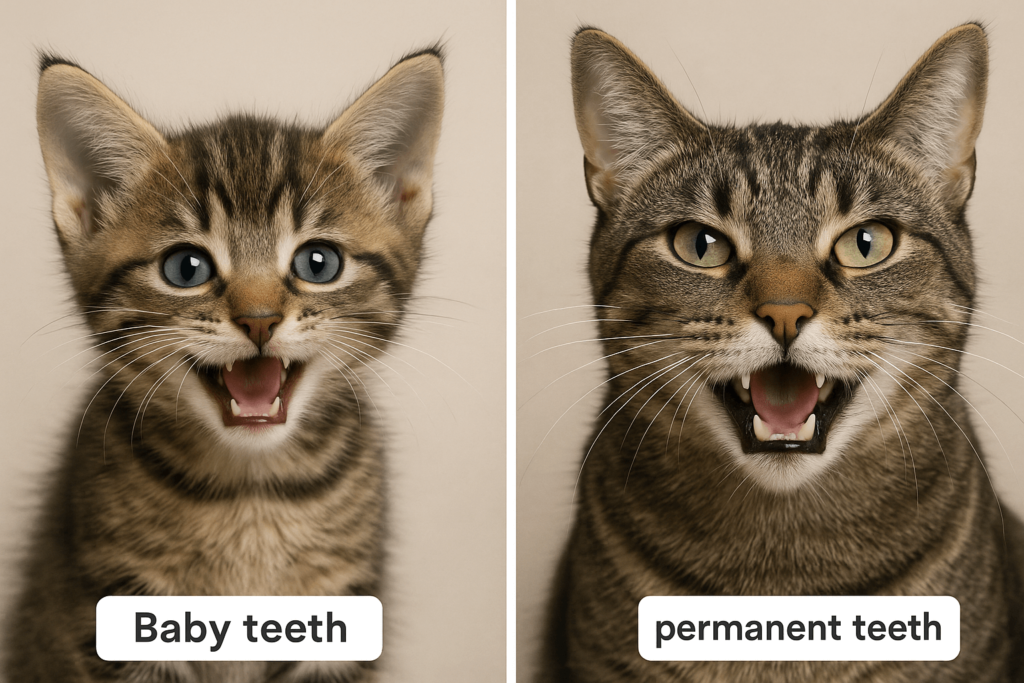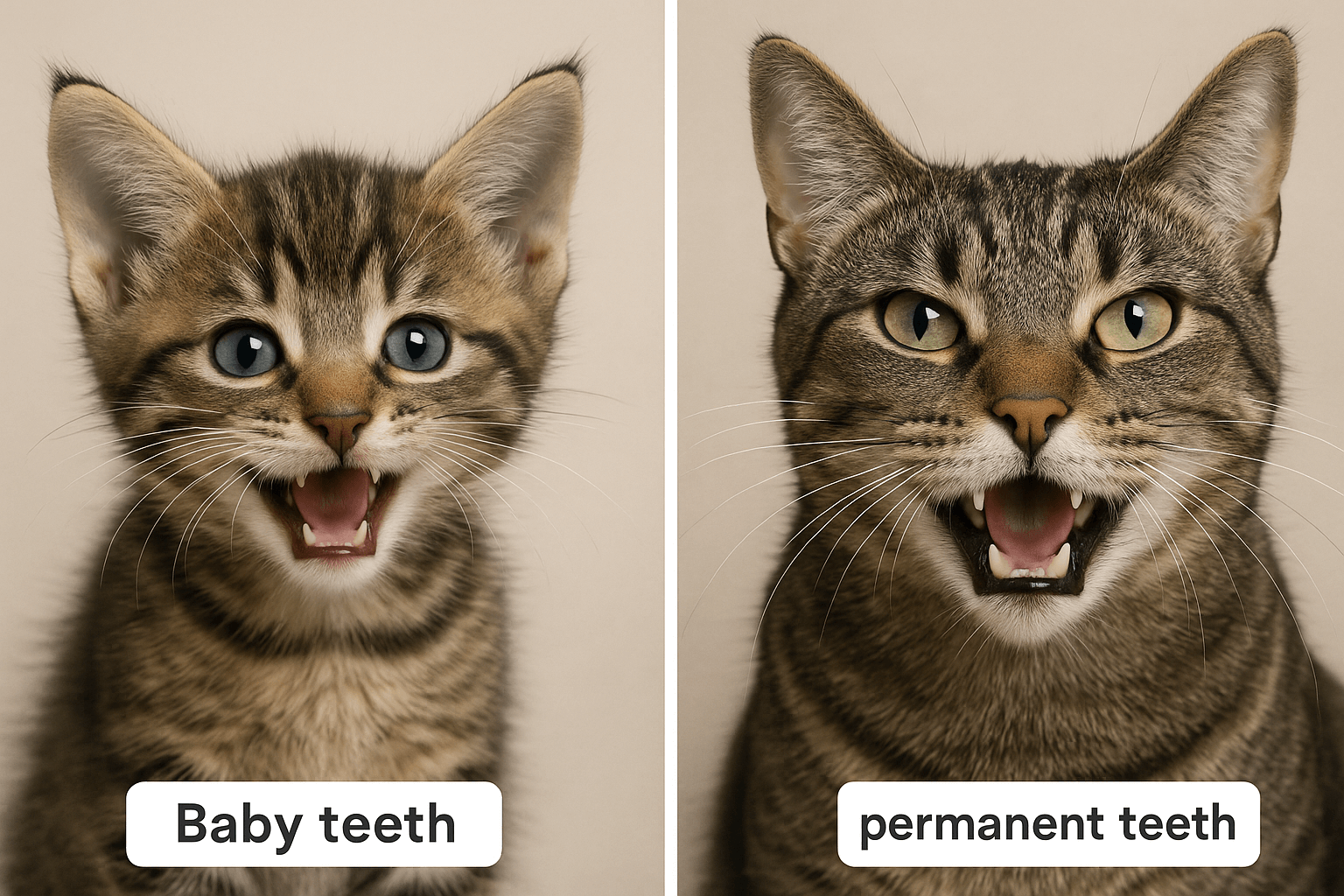Cat Baby Teeth vs Permanent Teeth: What Every Cat Owner Should Know
Just like humans, cats go through a natural process of losing their baby teeth and developing permanent ones. Understanding the differences between cat baby teeth and permanent teeth is crucial for ensuring your feline friend’s oral health throughout their life. From the timing of teething to recognizing potential dental issues, this guide will walk you through everything you need to know about your cat’s teeth. Whether you’re a new kitten owner or simply curious about feline dental development, this blog post will provide valuable insights into maintaining a healthy smile for your furry companion.
Key Differences Between Baby Teeth and Permanent Teeth in Cats
Kitten teeth and adult cat teeth differ significantly in size, structure, and function. Recognizing these distinctions can help you monitor your cat’s dental development effectively.
Size and Appearance:
Baby teeth are smaller, sharper, and whiter than permanent teeth, which are larger and more durable for chewing.Number of Teeth:
Kittens have 26 baby teeth, while adult cats typically develop 30 permanent teeth as they mature.Purpose and Function:
Baby teeth are designed for early-stage eating, while permanent teeth are built for tearing meat and grinding food.Tooth Replacement Process:
Baby teeth fall out gradually between 3 and 6 months of age, making way for stronger permanent teeth.Gum Health Indicators:
Healthy gums should appear pink and firm around both baby and permanent teeth; redness or swelling may indicate dental problems.
Understanding these differences ensures you can spot abnormalities early and maintain your cat’s oral hygiene.

Signs Your Kitten Is Teething
Teething is a normal part of kitten development, but it can sometimes cause discomfort or behavioral changes. Here are some signs that your kitten is transitioning from baby teeth to permanent teeth.
Chewing on Objects:
Kittens often chew on toys, furniture, or even your hands to relieve gum soreness during teething.Drooling or Excessive Saliva:
Increased saliva production is common as teeth push through the gums, leading to occasional drooling.Loss of Appetite:
Some kittens may eat less due to gum discomfort, though this usually resolves quickly once the new teeth emerge.Finding Baby Teeth Around the House:
You might notice tiny, sharp teeth on the floor or in your kitten’s bed as they fall out naturally.Mild Irritability:
Teething kittens may seem cranky or restless as their gums adjust to the changes.
By recognizing these signs, you can provide comfort and support during this important developmental stage.
Check this guide 👉Healthy Cat Teeth vs Unhealthy: Best 7 Expert Tips!
Check this guide 👉Understanding Cat Teeth Plaque: Best 7 Expert Tips!
Check this guide 👉How Should Cat Teeth Look? Best 7 Expert Tips!
Characteristics of Baby Teeth | Characteristics of Permanent Teeth |
|---|---|
Smaller and sharper | Larger and stronger |
Total of 26 teeth | Total of 30 teeth |
Fall out by 6 months of age | Fully developed by 6-9 months |
Designed for soft food | Built for tearing and chewing |
Temporary and fragile | Long-lasting and durable |
How to Care for Your Cat’s Teeth During Teething
Proper dental care during the teething phase sets the foundation for lifelong oral health. Here are some tips to help your kitten transition smoothly from baby teeth to permanent teeth.
Provide Safe Chew Toys:
Offer soft, kitten-safe chew toys to satisfy their urge to gnaw without damaging their gums.Monitor Food Texture:
Switch to softer kitten food temporarily if your kitten seems reluctant to eat dry kibble due to gum sensitivity.Check for Retained Baby Teeth:
Occasionally, baby teeth don’t fall out as expected, which can lead to overcrowding. Consult your vet if you suspect retained teeth.Clean Gums Gently:
Use a damp cloth to wipe your kitten’s gums and emerging teeth to remove food particles and bacteria.Schedule Regular Vet Checkups:
Routine dental exams ensure your kitten’s teeth are developing properly and address any concerns early.
With attentive care, you can make the teething process comfortable and promote strong, healthy permanent teeth.
Preventing Dental Issues in Adult Cats
Once your cat has developed its permanent teeth, ongoing dental care is essential to prevent common issues like tartar buildup and gum disease. These tips will keep your cat’s teeth in top condition.
Brush Their Teeth Regularly:
Use a pet-safe toothbrush and toothpaste to clean your cat’s teeth at least 2-3 times per week.Offer Dental Treats:
Specialized treats designed to reduce plaque and tartar can complement regular brushing routines.Encourage Crunchy Foods:
Dry kibble helps scrape away debris from the surface of teeth, promoting cleaner teeth over time.Watch for Bad Breath:
Persistent bad breath may indicate underlying dental problems that require veterinary attention.Avoid Sugary Treats:
Human foods or sugary snacks can harm your cat’s teeth and overall health—stick to species-appropriate options.
By prioritizing dental hygiene, you can extend the lifespan of your cat’s permanent teeth and improve their quality of life.
Common Dental Problems in Cats
While cats generally have strong teeth, certain conditions can arise if their oral health isn’t maintained. Being aware of these issues allows you to take preventive measures and seek timely treatment.
Gingivitis:
Inflammation of the gums caused by plaque buildup; early intervention prevents progression to more severe diseases.Periodontal Disease:
Advanced gum infection that damages supporting structures of the teeth; requires professional cleaning and possibly surgery.Tooth Resorption:
A painful condition where the tooth enamel erodes, affecting up to 50% of adult cats.Fractured Teeth:
Chewing hard objects can crack or break teeth, leading to infections or abscesses if untreated.Halitosis (Bad Breath):
Often a sign of underlying dental problems, such as decay or gum disease.
Addressing these issues promptly ensures your cat maintains optimal dental health and avoids unnecessary discomfort.
How Diet Impacts Feline Dental Health
Your cat’s diet plays a significant role in maintaining healthy teeth and gums. Choosing the right foods and treats can reduce the risk of dental problems as they grow.
Wet Food Benefits:
Moist food keeps cats hydrated and reduces dry residue that contributes to plaque formation.Dry Kibble Advantages:
Crunchy textures help scrub away plaque and tartar buildup when eaten regularly.Raw Diets for Dental Health:
Some owners opt for raw diets, which mimic natural prey and encourage chewing that strengthens teeth.Avoid Starchy Foods:
Carbohydrate-heavy diets promote bacterial growth and accelerate tartar accumulation.Supplement with Dental Chews:
Specially formulated chews target plaque and freshen breath while satisfying your cat’s natural urge to chew.
A balanced diet tailored to your cat’s needs supports not only their teeth but also their overall well-being.
Signs of Dental Pain in Cats
Cats are masters at hiding pain, but subtle signs can reveal underlying dental issues. Paying attention to these indicators helps you catch problems before they worsen.
Difficulty Eating:
Reluctance to eat or favoring one side of the mouth suggests discomfort or pain.Pawing at the Mouth:
Cats may paw at their face or rub it against surfaces to alleviate irritation.Excessive Drooling:
Unusual drooling can signal gum inflammation or other oral problems.Swollen or Bleeding Gums:
Visible swelling or blood on toys/food bowls indicates advanced dental disease.Behavioral Changes:
Increased aggression, withdrawal, or lethargy may stem from undiagnosed dental pain.
Early detection and treatment are key to preventing complications and restoring your cat’s comfort.
Frequently Asked Questions About Cat Baby Teeth vs Permanent Teeth
When do kittens start losing their baby teeth?
Kittens typically begin losing their baby teeth around 3-4 months of age, completing the process by 6 months.
What happens if a baby tooth doesn’t fall out?
Retained baby teeth can cause overcrowding and increase the risk of dental issues; removal by a vet may be necessary.
Can I brush my kitten’s teeth during teething?
Yes, gentle cleaning with a damp cloth can help maintain oral hygiene without irritating sensitive gums.
How many teeth does an adult cat have?
Adult cats have 30 permanent teeth, including incisors, canines, premolars, and molars.
Are dental problems common in cats?
Yes, periodontal disease affects many adult cats, underscoring the importance of regular dental care.
Supporting Your Cat’s Dental Development Throughout Life
From the first tiny baby teeth to the sturdy permanent set, your cat’s dental journey is a vital aspect of their overall health. By understanding the differences between baby teeth and permanent teeth—and knowing how to care for them—you can ensure your cat enjoys a lifetime of pain-free chewing and bright smiles. Regular monitoring, proper nutrition, and professional guidance will help you stay ahead of potential dental issues. Remember, a happy cat starts with healthy teeth, so give your feline friend the care they deserve today!
Cat Fever Treatment: Best 7 Expert Tips! Discover expert advice on identifying, managing, and treating fever in cats to ensure their quick recovery and well-being.
Understanding Meloxicam for Cats: Best 7 Expert Tips! Learn how to safely administer meloxicam, manage side effects, and ensure your cat's comfort with expert advice on feline pain relief.
Amoxicillin for Cat UTI: Best 7 Expert Tips! Discover safe usage, dosage guidelines, and expert advice on treating feline urinary tract infections effectively with amoxicillin.
Understanding Cat Cancer Treatment: Best 7 Expert Tips! Discover expert advice on managing feline cancer, from early detection to treatment options, ensuring your cat’s health and comfort.





